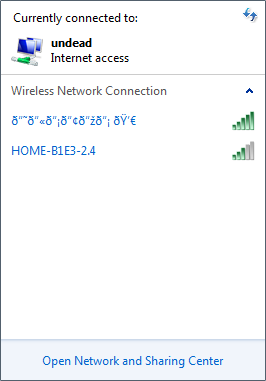
Earlier today, Ars IT editor Sean Gallagher was doing some scary things with wireless when he discovered someone probing for a Wi-Fi network with a name that appeared to be something un-parseable. I theorized that it was actually something in Unicode that Wireshark wasn't parsing properly. "So someone has a Unicode SSID?" Gallagher asked, incredulous.

I was inspired. I wanted a Unicode SSID—one that could match the season and give my network name a seasonal gothic flare. So I set out to see if I could do it with my own Wi-Fi network. While I was successful, the effect may be lost on Windows users and others on devices that can't handle Unicode characters in their wireless network name. And as Gallagher determined, it doesn't work on all Wi-Fi networking hardware.

The tools
Unicode has some fun characters that can be used to generate a spooky SSID, but it can be difficult to type these characters using a traditional keyboard. After some digging around, I found the excellent Unicode Text Converter. This page allows you to enter a simple string and get back a variety of clever representations.
On OS X you can hit Control-Command-Space while entering text to get a handy pop-up for selecting hard-to-type characters.
SSID length limitations
In my testing, most operating systems seem to limit the SSID to 32 characters, or more to the point, 32 bytes. The bytes part is important, because unlike ASCII, Unicode characters can consist of multiple bytes. That means that you may be limited to as few as 6 characters for your spooky Halloween SSID. For example, the SSID "𝔘𝔫𝔡𝔢𝔞𝔡 💀" is 29 bytes, leaving very little room for any additional characters. This quick terminal command allowed me to determine exactly how many bytes each character is using:
lee@trillian:~$ pbpaste|perl -C -MEncode -E 'say "$_ : " . length encode utf8 => $_ for split "", <>' 𝔘 : 4 𝔫 : 4 𝔡 : 4 𝔢 : 4 𝔞 : 4 𝔡 : 4 : 1 💀 : 4
Setting the SSID on an Apple Airport
To update your SSID on an Airport device, follow the following steps:
- Use the Unicode Text Converter to come up with an SSID, and copy it.
- Launch Airport Utility, select your device, and click Edit.
- Under the Wireless tab, paste your text into the Wireless Network Name.
- If you hear a beep, that means it is too long. Try the Terminal command above to make sure you're at or below 32 bytes.
- Click Update, and wait for your device to reboot.
- Sleep well knowing your neighbors think you're crazy.
Other access points
Gallagher has tried similar instructions on a Netgear router, with little luck. It seems that at least some non-Apple devices wisely prevent non-latin characters in the SSID. See below for exactly why they would choose to do that.

Prepare yourself for Mojibake
When the UTF-8 SSID subfield of the Extended Capabilities element is equal to 1 in the frame that includes the SSID element, the SSID is interpreted using UTF-8 encoding.
Despite the above quote from the 802.11 IEEE spec, you will quickly discover what software is capable of handling a UTF-8 encoded SSID. So far, the worst that I have encountered is on Windows, which decodes the UTF-8 as latin characters. Despite the faulty decoding, Windows still connects to the wireless network just fine.
It is possible that other software could handle things much worse, so be careful!


reader comments
91